XLR Connectors
XLR connectors are the mainstay connector type for many audio and lighting applications - there are several types with different pin numbers and pinouts.
Home » Electronic components » this page
Connector Technology Includes:
Connector basics
Connector types
Specifications
Selecting the right connector
D-type connector
IEC power connector
Jack connector
XLR connector
IDC connector
PCB edge connector
DIN 41612 connector
The XLR series of connectors is widely used for audio and video applications, appearing in many applications where they are seen as the professional connector for audio applications.
The XLR connectors provide a rugged series of connectors that can be used for professional as well as semi-professional applications.
In view of their performance and ruggedness, XLR connectors are used on most serious audio mixing desks, and on high quality microphones, as well as for many other audio applications.
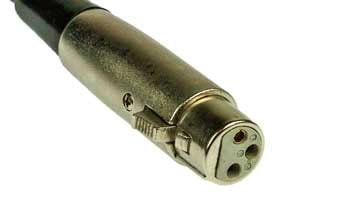
XLR connector development
The XLR series connectors started life as the Cannon X series of connectors from Cannon Electric which has since been taken over by ITT Corporation.
The original Cannon X connector was quite successful, but modified around 1950 with a latch to prevent it working loose when accidentally pulled or subject to use of vibration. At this point it was known as the Cannon XL connector.
A further upgrade occurred around 1955 when the contacts were surrounded with a synthetic rubber to give the XLR part number. A version using a plastic insulation was also used and this had the family part numbering of XLP, although this is not seen these days.
Since the early introduction of the XLR connector, other manufacturers started to manufacture compatible parts and now they have become a standard part for semiprofessional and professional audio applications.
XLR connector basics
XLR connectors of all pin number variants are available in male and female versions, i.e. XLR plugs and XLR sockets, both cable and chassis mounting options. This enables all requirements to be met as male and female versions are needed to ensure that male and female gender conventions can be accommodated.
One important aspect of the XLR connector is that when two of them mate, Pin 1, which normally carries the earth connection is the first to make contact. This ensures that during connection the ground connection is made first and then the other lines. This helps ensure that if connections are mated, then the external pickup and loud levels of hum are less likely to manifest themselves if the line is live.
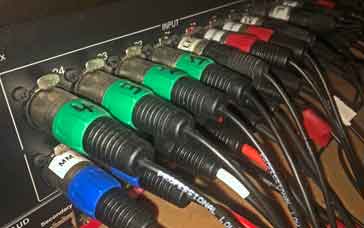
XLR connectors are available in variants with up to ten pins for the standard sized connectors, and the mini variants are available with up to eight.
In view of the standardisation, connectors from different manufacturers will mate together quite easily. This is ideal because in any audio system, connectors from many different manufacturers are likely to have been used.
The only exception to this can be the six pin variety where two incompatible designs have been available over the years. The older design from Switchcraft for the 6 pin connector added a centre pin to the standard 5 pin design, whereas the newer Neutrik design uses a different pattern.
XLR connector variants
There are several different XLR connector formats, mainly caused by different pin numbers. Whatever the pin number count for a connector, the same basic XLR connector philosophy and style are adopted.
The XLR connector variants that are most widely used are outlined below:
XLR 3 Pin: The most popular style for the XLR connector is the three pin variant. This is the type that is used for audio applications: it is seen on many microphones, mixer inputs, amplifier inputs, audio extension leads and many more items.
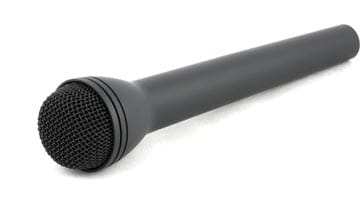
This dynamic microphone uses an XLR connector The XLR 3, as the designation implies has three connections and these have standard designations which are used virtually universally - in fact if you change them, then use the connections at your peril as everyone uses the standard pin connections.
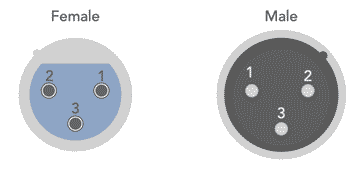
Standard connection pinout for a 3 pin XLR connector
Viewed from pin sideStandard Pin Connections for an XLR 3 Connector used for a Microphone
Pin number Function 1 Chassis / ground (cable shield) 2 Positive polarity (hot) + 3 Return (Cold) - 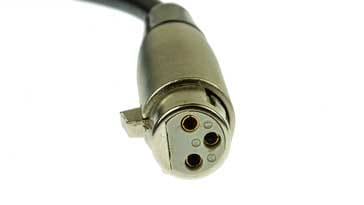
Female XLR connector on a lead showing pin numbering
Note: it is possible to see the connector receptacle on pin 1 is further out than on pins 2 & 3If the XLR cable is to be used with an unbalanced system Pins 1 & 3 are often connected together. This would normally be done int he equipment and then standard cables can be used.
3 pin XLR connectors have in the past been used for loudspeaker systems. This is not longer standard and Speakon connectors are now generally used. However there are often older loudspeaker systems that may be used and these can have three pin XLR connectors. The standard connections for loudspeaker systems are given int he table below:
Standard Pin Connections for an XLR 3 Connector used for a Loudspeaker **
Pin number Function 1 Negative SIgnal 2 Positive signal 3 Not connected ** the use of XLR connectors for loudspeakers is not recommended as it can lead to damage of amplifiers and the like if the wrong cables are used.
A wide variety of 3 pin connectors as well as XLR microphone cables, etc are available and can be bought from a variety of different suppliers.
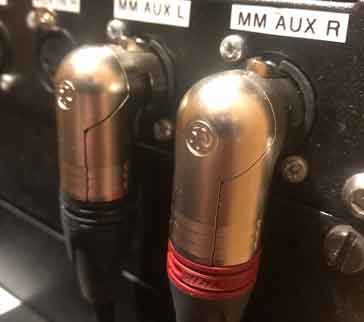
Right angled XLR connectors are not particularly common, but can be used to save space behind rack as the connector is shorter and the cable bend radius not an issue. Normally the XLR microphone cables are manufactured with robust cabling to ensure that they are able to withstand the heavy usage many of them get in professional and semiprofessional applications.
XLR 4: The XLR 4 or 4 pin connector is used in a number of applications. Although not nearly as widely used as the 3 pin XLR connector, it nevertheless finds uses in a number of areas.
Some of the main uses of the XLR 4 are intercom headsets where they often used: two pins are used for the mono headphone signal and two for the unbalanced microphone signal.
The XLR4 is also used for proving DC power for professional video cameras and their related equipment, and in addition to this, some desk microphones that have LEDs for indicators for when the microphone is live or "ON AIR" etc.
XLR 5: The five pin XLR connector is the standard connector for the DMX512 digital lighting control system. The five pin XLR is also used for stereo microphones where the five ins are able to provide a screen as well as two separate balanced lines for the two stereo signals. The five pin connector can also be used for DC power and control for various forms of audio equipment.
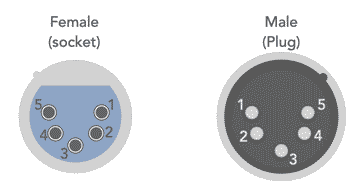
Standard connection pinout for a 5 pin XLR connector
Viewed from pin sideStandard Pin Connections for an XLR 5 Connector used DMX512 Lighting Control
Pin number Function 1 Earth / Shield 2 Negative signal 3 Positive signal 4 Not used * 5 Not used * * These lines were originally intended to provide a link for diagnostic data feedback for the DMX512 controller, but this was never implemented. The lines are sometimes used to carry other data or power.
XLR adapters
There are many instances when XLR adapters are required. Occasionally gender adapters are needed to enable male to male or female to female connections to be made.
Another popular form of XLR adapter is an XLR to standard jack, or even other versions of jack connector. As jack connectors are used with many guitar amplifiers and the like, there is often a need to change between the XLR format and the jack standard.
Although it is possible to buy or make a lead with XLR on one end and jack on the other, it is often more convenient to have an adapter that changes between the two.
When using XLR adapters of various forms and especially XLR to jack connector, remember that XLR connectors often carry a balanced signal, whereas a jack connector is unbalanced. It may be necessary to use a DI box (Direct Injection box) to provide the transition between balanced and unbalanced. If used, a DI box is likely to have XLR and jack connections and in this way provide the transition from XLR to jack, making an adapter unnecessary.
Buying XLR connectors
When buying XLR connector there are several points to consider to get the best connector for the particular application in mind.
Cost: Cost can be a real driver for the decision about which XLR connector to buy. If the connector is to be used for a relatively benign environment, then lower cost items can be considered, but if it is to be used in an area where top quality is needed then higher cost items might be better.
Quality: Quality is a term that is hard to quantify for many components, but opting for a manufacturer known for their quality will give a good quality component. It will be more robust and stand the test of being used in a professional environment.
With some lower quality XLR connectors it can be found that the latches do not work as well, especially with connectors from other manufacturers.
Manufacturers such as Neutrik are known for their high quality XLR connectors, although often at a price.
IP ratings: It is possible to obtain IP rated XLR connectors. Their IP rating means that they will have been manufactured to withstand adverse environmental conditions. Although mating can be a little more difficult because of the environmental protection need to prevent ingress of moisture, etc., these can be ideal for use where cables are used outside and may have to withstand rain, etc.
XLR connectors are the industry standard connector for professional and also semiprofessional audio and many lighting applications. They are available in many formats and many manufacturers make them.
When buying a connector, it is always worth buying a good quality connector from a source that can be relied upon the provide the genuine connector from the required manufacturer. In this way good reliable service will be obtained over a long period of time.
 Written by Ian Poole .
Written by Ian Poole .
Experienced electronics engineer and author.
More Electronic Components:
Batteries
Capacitors
Connectors
ADC
DAC
Diodes
FET
Inductors
Memory types
Phototransistor
Quartz crystals
Relays
Resistors
RF connectors
Switches
Surface mount technology
Thyristor
Transformers
Transistor
Unijunction
Valves / Tubes
Return to Components menu . . .




